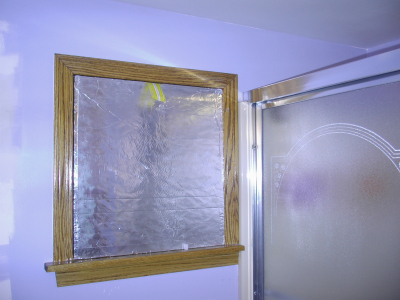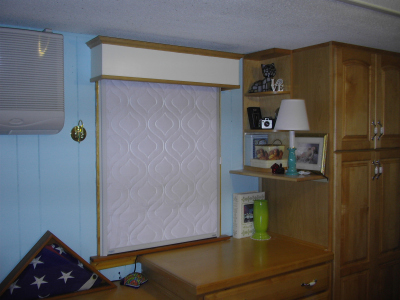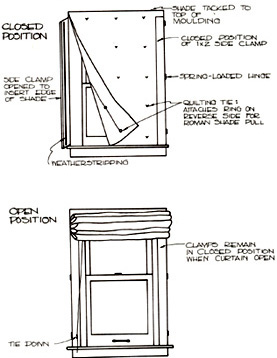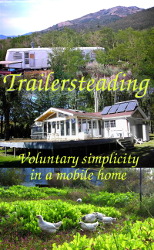
How to insulate windows
 Although
I usually think that buying insulation for the ceiling is the quickest
and cheapest way to improve heating efficiency, one
article I read
suggested that I was on the wrong track. They noted that
infiltration and air leakage are the most problematic causes of heat
loss in the winter, making up around 35% of all heat lost from the
average home. Windows and doors followed behind at 18 to 20%,
then floors at 15 to 18%, walls at 12 to 14%, and finally ceilings at
10%. Clearly, fixing any holes or cracks should be your first
priority, closely followed by dealing with windows and doors.
Although
I usually think that buying insulation for the ceiling is the quickest
and cheapest way to improve heating efficiency, one
article I read
suggested that I was on the wrong track. They noted that
infiltration and air leakage are the most problematic causes of heat
loss in the winter, making up around 35% of all heat lost from the
average home. Windows and doors followed behind at 18 to 20%,
then floors at 15 to 18%, walls at 12 to 14%, and finally ceilings at
10%. Clearly, fixing any holes or cracks should be your first
priority, closely followed by dealing with windows and doors.
 We
installed double-glazed windows in our trailer, but even the air gap
between those panes of glass is a drop in the bucket.
Double-glazed windows tend to have an R-value around 2 --- compared to
a preferred R-value
of at least 13 in walls. Is there a way to
make windows more efficient without living in a cave?
We
installed double-glazed windows in our trailer, but even the air gap
between those panes of glass is a drop in the bucket.
Double-glazed windows tend to have an R-value around 2 --- compared to
a preferred R-value
of at least 13 in walls. Is there a way to
make windows more efficient without living in a cave?
Zimmy made some quick
and easy window coverings to insulate his windows when they aren't in
use. He used foam board on basement windows and some upstairs
windows (top photo), then bought quilted window blinds for windows in
his main living space (second photo.) The quilted blinds run on a
track and  seal
all around the window. I estimate that Zimmy gets an additional
R-6 from his foam board (although the gaps at the edge of the foam
board may drop this down some) and perhaps as high as R-7 for his
quilted blinds.
seal
all around the window. I estimate that Zimmy gets an additional
R-6 from his foam board (although the gaps at the edge of the foam
board may drop this down some) and perhaps as high as R-7 for his
quilted blinds.
Maine
Home Energy has a
very well put together page about different window insulation options,
including price per square foot and R-value of each. They
recommend quilted blinds like Zimmy's (which they call "insulated Roman
shades") on south-facing windows since they are easy to open for
passive solar gain on sunny days, then seal shut for the night or on
cloudy days. Insulating windows has always been on our priority
list, but after reading the statistics on heat lost through windows,
then seeing simple how-to instructions for making our own insulating
blinds, I think this project will have to move closer to the top.
| This post is part of our Energy Efficient Mobile Home lunchtime
series.
Read all of the entries: |

Edited to add:
Learn more about insulating and improving the efficiency of a mobile
home in Trailersteading. Now available for
$1.99 on Amazon.
Want more in-depth information? Browse through our books.
Or explore more posts by date or by subject.
About us: Anna Hess and Mark Hamilton spent over a decade living self-sufficiently in the mountains of Virginia before moving north to start over from scratch in the foothills of Ohio. They've experimented with permaculture, no-till gardening, trailersteading, home-based microbusinesses and much more, writing about their adventures in both blogs and books.
Want to be notified when new comments are posted on this page? Click on the RSS button after you add a comment to subscribe to the comment feed, or simply check the box beside "email replies to me" while writing your comment.

Don't go overboard on sealing everything up. A normal living room should have enough ventilation for 3--5 air changes per hour. A kitchen should have 10--15!
There has been a trend to make houses too airtight to keep the warmth in. But this did not provide enough ventilation and can give problems with mold. That's why modern houses tend to have a forced ventilation system with a heat exchanger in it to reclaim heat from the expelled air.
And keep in mind there are many kinds of double glazing. In the best ones (known as HR++ here in the Netherlands, or low-emissivity glass) the inside pane has an extremely thin metal coating then lets in solar radiation but blocks the escape of longer wavelength IR.
That reminds me of an anecdote Mark's aunt likes to tell. She says that when she took home ec in high school, she learned these exact statistics and brought them home to her family. She was concerned that the house might be sealed up too tightly for their health, but her mother just laughed at her. They were dirt poor, and their house had no insulation and big cracks between the boards in the walls. Clearly, too little infiltration wasn't going to be a problem.
Short of installing a fancy ventilation system, though, what do you think is the best way to let air move around without losing too much heat? Keep your cracks near the floor?
Well, when the temperature is right you can just open a window.
In the winter the best solution would be a heat exchanger. Ideally, you'd want the air leaving the house to have the outside temperature, while you want the incoming air to be 20 ℃. Seal up the cracks and the windows and make dedicated inflow and exhaust channels. The heat exchanger will transfer heat between them.
A passive heat exchanger will need a large surface area to work well because of the relatively low temperature difference. And that high surface area translates into a lot of resistance. I'm not sure if this will work well without a fan.
An active heat exchanger (a heat pump) would work better. You could scavenge a small fridge. Put the evaporator (the cold bit) in the outgoing air channel to capture heat. The fridge needs to be adjustable so you don't get ice forming on the evaporator. Put the condensor (the warm bit) in the incoming air flow. Of course this will use some electricity, but you get that back as extra heat so it's not lost. Because of the bigger temperature difference between the air and the working fluid, heat transfer should work well.
If you combine this heat pump system with the underground pipes we've discussed earlier you could also take advantage of a stable 14 ℃ incoming air summer and winter. In the winter you'd only have to heat this air 6 ℃ to get to a comfortable 20 ℃, and in the summer you've got cool air when you want it.
Of course you should always use a filter in both flows before the heat exchangers. Otherwise they will foul up quickly and lose efficiency.
And it would be wiser to tackle the isolation first, I think. I suspect you trailer holds heat about as well as a sieve. But it would be nicer to know than to guess where your house is leaking heat. For that you'll need an infrared camera. You can rent these, but they are expensive.
But it would be nicer to know than to guess where your house is leaking heat. For that you'll need an infrared camera. You can rent these, but they are expensive.
You know, digital camera sensors are sensitive into the infrared, but this is usually filtered out. By removing that filter and installing a visible light filter they would make a passable IR camera which could tell you where your house is leaking heat when you do a walkaround in the winter. Some digital (video) cameras have a filter that can be switched off, maling the camera an infrared one. E.g. Sony calls this feature "NightShot".
Great post. Good job on prioritizing your most important sources of energy loss. It is good to seal around every penetration into your home, both at the point where they enter your home from the outside and at openings in your wall inside, like electric outlets.
It is very unlikely that you could over-seal your home. Your main concern would be if you had a fuel burning unit inside the house and there was significant incomplete combustion causing a build-up of CO. Definitely check CO levels regularly on such devices whether you are sealing the home more or not.
A lot of moisture is coming into your home through the cracks that already exist so you'll probably actually reduce moisture in the home by sealing. Just try to minimize moisture produced inside the home if possible (e.g. shorter showers?).
Your double windows may have an even lower equivalent R value if the internal seals are broken. You'll see moisture between the panes if they are. The space between the windows is supposed to be a vacuum which stops heat loss via convection.
It would be really neat if you could get someone local with an infrared camera to get a picture of your home in the winter to see exactly where you are losing the most heat.
Roland --- I love your idea of looking for a camera with a night shot option. I'll have to check out the fancy new camera Mark talked me into getting to see if that happens to be one of the options.
Lisa --- That's a very good point about moisture coming in the cracks. In our excessively rainy and humid climate, cracks probably do a lot more harm than good from a moisture perspective! And good point about the moisture meaning broken seals --- we have some windows like that. Could I just use a tube of silicon to seal up the edges of the glass better?
Unfortunately, nothing fixes the thermal seals if they have broken. I would say just keep it in mind as a factor if you deciding whether to replace windows or if you are choosing a repurposed replacement window.
I think you have the priorities right based on the level of investment I think you willing to make. Your priorities would be sealing your home's envelope, sealing and insulating any ductwork (if you have any for your heating system - not sure what your system is), and using some kind of window covering. After that next priority would be insulating the whole home then upgrading windows if it is cost-effective.